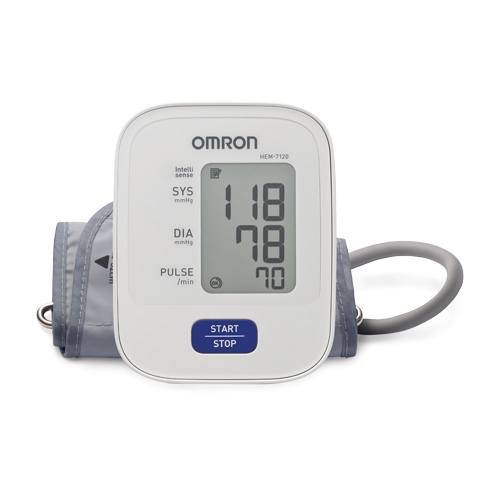Possibly the most well-known type of monitor is the traditional sphygmomanometer blood pressure meter that is commonly used by health-care professionals. It consists of an arm cuff, a stethoscope and a mercury gauge. It is renowned for giving accurate and repeatable readings. But it is large and cumbersome and not really suited for home use. The two primary types for personal use are the manual manometer and the automatic digital monitors. All monitors have a cuff. The cuff has a rubber inner layer that squeezes your arm when inflated and an outer layer made of nylon or similar material that has a means to fasten the cuff in place on your arm.
Manual Blood Pressure Monitor

The manual monitor has a gauge that is read by looking at a pointer on a dial. The cuff is placed around your upper arm and inflated by squeezing a rubber bulb. The cuff is then allowed to deflate while using a stethoscope to listen to your blood flow and to check your heart rate. Manual monitors are usually less expensive than automatic monitors but require a certain level of expertise to operate. Because of the need to listen to blood flow with the stethoscope, the manual monitor may not be appropriate for hearing-impaired people.
Automatic Blood Pressure Monitor
The Blood Pressure Monitors is much easier to use than the manual type and is the most popular blood pressure measuring device for individual use. The cuff automatically inflates at the touch of a button. A sensor works with an internal computer to control the cuff deflation and to automatically sense, calculate and display heart rate and blood pressure information on a screen. Be aware that some models may still require manual inflation of the cuff. Some models give you an error message if the cuff isn’t positioned properly. Others can alert you to an irregular heartbeat. Some of these computerized monitors also store your information with the date and time and allow you to review previous readings. Some can connect to your computer to load the readings for storage and display.
There are three types of automatic monitors: finger, wrist and arm. Arm types are the most accurate for most users. Finger and wrist devices may have issues with measuring blood pressure accurately, since they are sensitive to position and body temperature. Which One for You? For most people, the automatic monitor will be the best choice. Just be sure to select the one that has the features that you desire.